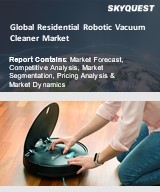
Report ID: SQMIG20N2031

Report ID:
SQMIG20N2031 |
Region:
Global |
Published Date: May, 2024
Pages:
204
|
Tables:
88 |
Figures:
72
In the global residential robotic vacuum cleaner market, one dominant region is North America. North America holds a leading position in the market due to several key factors. Firstly, the region has a high level of technological adoption and consumer acceptance of smart home devices, including robotic vacuum cleaners. Consumers in North America are generally early adopters of innovative technologies, and the convenience and automation offered by robotic vacuum cleaners align well with their busy lifestyles. Secondly, North America is home to several key players and manufacturers in the robotic vacuum cleaner market, contributing to the availability and variety of products in the region. These companies invest in research and development to continuously improve the performance, features, and capabilities of robotic vacuum cleaners, catering to the preferences and demands of North American consumers. Furthermore, the growing trend of urbanization and the increasing number of households with dual incomes in North America have resulted in a greater demand for time-saving devices like robotic vacuum cleaners. With limited time available for household chores, consumers in North America are willing to invest in robotic vacuum cleaners to automate cleaning tasks and free up time for other activities.
The Asia-Pacific region stands out as the fastest-growing region in the global residential robotic vacuum cleaner market. Several factors contribute to the rapid growth observed in this region. Firstly, the Asia-Pacific region is home to some of the world's largest and fastest-growing economies, including China, Japan, South Korea, and India. Economic development, rising disposable incomes, and urbanization in these countries have fuelled demand for home appliances, including robotic vacuum cleaners, as consumers seek to enhance their quality of life and adopt modern conveniences. Secondly, technological advancements and the proliferation of smart home technologies have contributed to the adoption of robotic vacuum cleaners in the Asia-Pacific region. As awareness of home automation grows and consumers become more tech-savvy, there is increasing interest in robotic vacuum cleaners as time-saving devices that can automate household chores and provide convenience. Moreover, changing lifestyles, busy urban environments, and smaller living spaces in many Asian cities have made robotic vacuum cleaners particularly appealing to consumers. With limited time available for household chores and the desire for clean living environments, robotic vacuum cleaners offer a practical solution for maintaining cleanliness with minimal effort.
Europe is another prominent market for residential robotic vacuum cleaners, with countries such as the United Kingdom, Germany, and France leading in adoption rates. Increasing urbanization, changing lifestyles, and a growing emphasis on sustainability and energy efficiency contribute to market growth in Europe. Consumers in this region value design aesthetics, cleaning performance, and environmental sustainability when choosing robotic vacuum cleaners. Regulatory initiatives promoting energy efficiency and eco-friendly products influence product development and marketing strategies in the European market.
Our industry expert will work with you to provide you with customized data in a short amount of time.
REQUEST FREE CUSTOMIZATIONWant to customize this report? This report can be personalized according to your needs. Our analysts and industry experts will work directly with you to understand your requirements and provide you with customized data in a short amount of time. We offer $1000 worth of FREE customization at the time of purchase.

Report ID: SQMIG20N2031